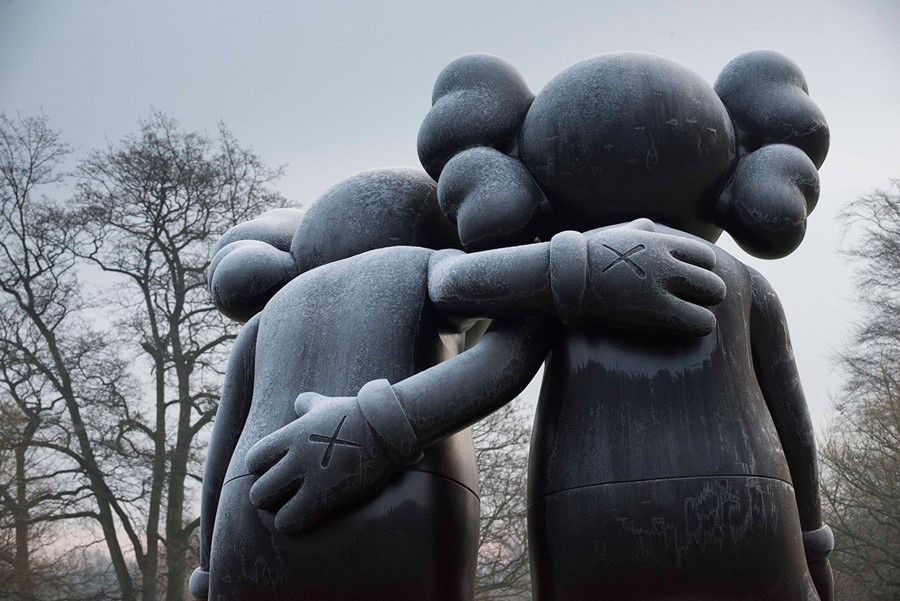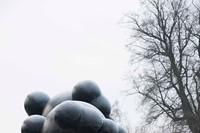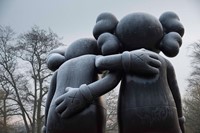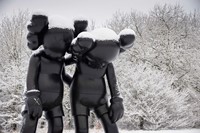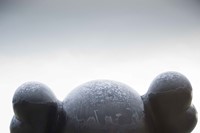As his new exhibition of behemoth creatures opens at Yorkshire Sculpture Park, we sit down with artist KAWS for an introduction to his sensational work
When New Jersey-born Brian Donnelly took up spray painting and graffiti, he chose his guerrilla name by simply picking four random letters that worked well together: KAWS. His first foray into art, as a student at New York's School of Visual Arts, was to paint over advertisements on the back of phone booths in the middle of the night: fast-forward a few years, some lucky encounters and several long-haul flights to Japan, Donnelly has managed to become a household name, incredibly sought-after in the art and design communities alike.
When travelling to Japan in the late 90s, Donnelly became fascinated with the country's obsession with craftsmanship and decided to create a series of limited edition toys, which soon became cult objects amongst collectors, inspiring him to launch his own brand Original Fake (which he shut down in 2013) in the process. This, in turn, led to a string of collaborations, from an accessories line with Comme Des Garçons and a series of guitar picks with John Meyer, to Kanye West's 808s & Heartbreak album cover, and a new trophy for MTV's VMAs.
KAWS' three most recognisable characters, affectionately named Chum, Companion and Bendy, haven't only conquered store shelves – they have progressively grown into larger than life sculptures constructed out of bronze, fibreglass, aluminium and wood, and measuring up to ten metres tall. These gargantuan figures, any art lover will tell you, have grown in ubiquity as they have in size. These days the trio are in residence all over the world, from the streets of Hong Kong to Frieze Art Fairs.
Represented by Galerie Perrotin, Donnelly works from his studio in Brooklyn and travels the world, "although I've really cut down on travel since the birth of my daughter," he tells us. With his giant sculptures being installed on the grounds of Yorkshire Sculpture Park for a new exhibition opening this week, and a major 100-150 piece survey of his work coming up at Forth Worth in Texas come the Autumn, KAWS' work is in the spotlight now more than ever before. Here, the artist takes time out of his busy schedule to talk his dislike of labels, his love of Japan and his knack for fortunate encounters.
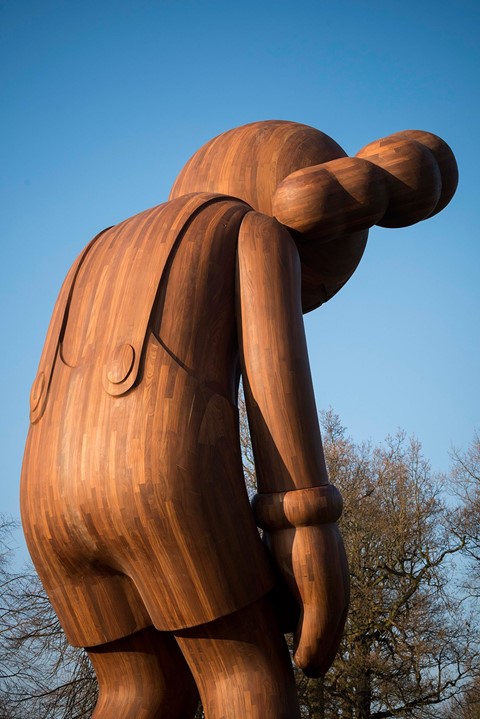
On starting out in graffiti...
"When I was doing graffiti, social media didn't exist: graffiti was just about leaving the house and painting stuff as a way of putting it out there. At that time, I didn't know a single person at a gallery, so there was no other way to show my work. I was also super young, and meeting other kids, and the community-type interaction was what interested me."
On the communities of makers he discovered in Japan...
"My first trip to Japan was in 1997, and I met kids that were my age or a little bit older than me who were working on really interesting stuff. There were all these stores – Hectic, Bathing Ape, Undercover, Neighborhood – and I met my friend James Jebbia, whose company Supreme I'd known since I was 15. It was really interesting to meet individuals who were making things and were entering that world; it made the idea that you can make things very accessible, that if you put energy into it, you can find out how. So you'd figure out how to make a T-shirt, and then you'd start to wonder how to make a jacket, and then how to make a sculpture and so on. I’ve been to Japan about 40 times, and it never gets boring."
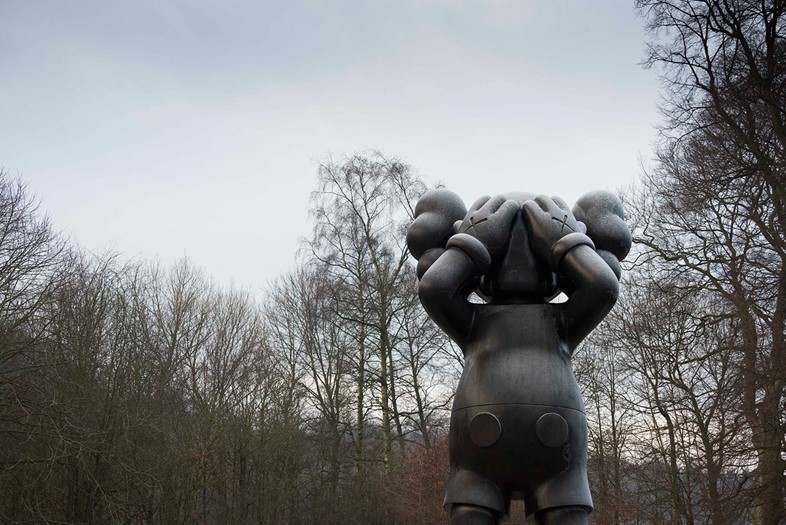
On fine art versus commercial art...
"In the 1990s in America, you had to choose between being a fine artist or a commercial artist, and if you wanted to pursue a fine art career you had to cut the commercial stuff out. In Japan I never felt that – they were just looking at pieces and creating objects. There was an integrity to it: they just had a different view and they respected craft and making stuff. Eventually what I was doing there bounced back to the US."
On the ambiguity of labels...
"I think it's because I continue to keep the name KAWS instead of Brian Donnelly that people tend to associate me with graffiti and street art, and that's the first thing they write. When you look at my work now, it really has nothing to do with that. I don't feel I need to identify with any medium in particular – I would hate if people pointed at me and said 'contemporary artist'. I'm a person making stuff. Some people just know me as a toy designer, then when I'm making clothing they say I'm a fashion designer."
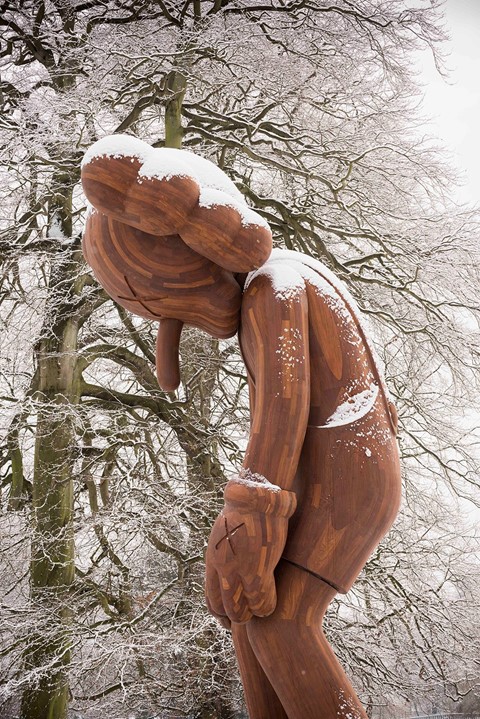
On lucky encounters...
"I met Pharrell through Nigo – Pharrell already knew my work so he just put us together. I met David Sims just walking into a restaurant – we were introduced by a mutual friend. He was like, 'oh, you guys would get along,' kind of making a joke, because I probably painted over David's work at the time when I was doing the phone booths. We did get along, though, and David invited me to London, where I went through all his negatives. He made original prints for me, and I took them back and painted them. They were collaborations just for us, it wasn't a commercial project."
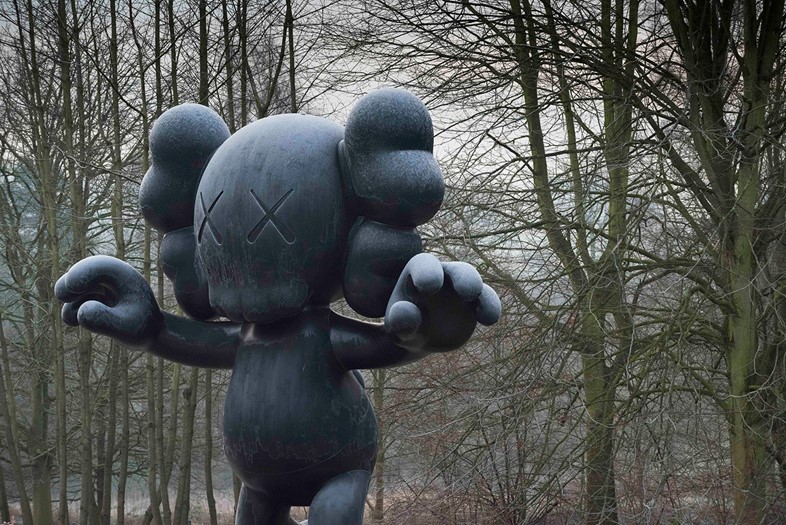
On the artists that inspire him...
"One of my favourite artists is H.C. Westermann. The first time I came across his work was at a show at the Stedelijk Museum called Eye Infection – it was an amazing show, it also had Mike Kelley and all his other peers, it really planted some seeds in me. I also very much like the Chicago Imagists, the Hairy Who; I think what the Chicago Imagists were doing was a more emotional, more sensitive version of American Pop Art. Anyway, over time I got to meet and become friends with them, especially Peter Saul (I collect his work from the 60s to the present), or Karl Wirsum. You find out about an artist and then you start looking at their peers, and who they were looking at the time they were coming up, and it sort leads you down a rabbit hole…"
On the value of local craftsmanship...
"When I am making something, I like to figure out the best places to produce it. You find different pockets of people in different places – so if I'm working with nylon, I know that Japan makes great stuff and we make sculptures in the Netherlands because I know a guy who has a foundry there who is really skilled. We cut the wooden pieces near Amsterdam, and then ship them to Maastricht for the hand-finishing, which is done by Ernst, who I also met through a mutual friend. It took a couple of years to figure out what to make together, and the wooden sculptures were our first project."
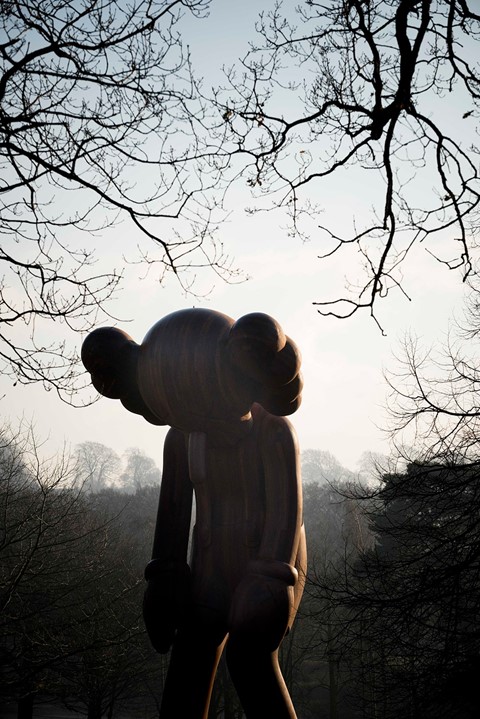
KAWS runs at Yorkshire Sculpture Park until June 12, 2016.
